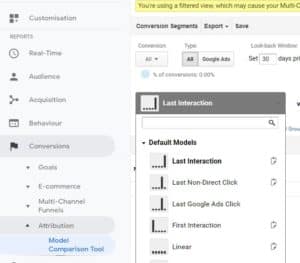“Half the money I spend on advertising is wasted; the trouble is I don’t know which half.” John Wanamaker (1838-1922) in today’s world this can be answered fairly reasonably and quickly with free services. These services include Google Analytics and Google Tag Manager but you might be reading the data wrong, jumping to conclusions that could damage your business.
Companies and marketing managers attribute sign ups to mediums too fast without understanding the entire users journey.
How Not To Make Under Formed Decisions
What most people aren’t aware of is the attribution model they are using could be misinforming them. The attribution model you use will tell you where the lead originally came from or what mediums they touched along the way that helped them convert.
If the only metric you are looking at is the last time they visited your site, which is the Google Analytics default, you could cause a lot of damage by turning off campaigns you think aren’t working.
This isn’t some new black magic trick that we have uncovered its just hidden in different section of Google Analytics. The hardest part is understanding how to use that information.
I’m going to use a scenario to explain this.
John is researching where is best to go on holiday in 2019 and comes across your blog “Top Destinations in 2019”. He reads it and leaves your website with little intention of buying. You have a remarketing campaign that shows an ad to John 5 days later which he clicks and sees your service offer. Another 7 days later John decides to book the trip, Google’s “trips to XYZ” and your Google Ad appears first. He clicks on the advert and makes the booking.
First Interaction
First interaction is how a user originally found you. If someone signs up to your service, Google will denote the original way they found your website as the source that made the conversion.
In the scenario John originally found your website through the blog. The conversion will be attributed to organic search.
Last Interaction
Last interaction will denote how a user found you the last time they visited your website before they signed up for your service and the medium they used right before they signed up.
The last time John interacted with the website before he made the booking, was through a google ad. Using the Last Interaction model will attribute Google Ads as the converting medium.
This is the default attribution model Google uses
Linear
Linear will denote a sign up to all mediums a user used during their journey. This spans from the first time they found you right through to the final visit when they signed up.
This will attribute the conversion to all mediums that assisted the conversion. In the scenario mentioned above the conversion would be attributed to Organic, Facebook and Google Ads
There are others but for the moment ignore them until you can fully understand the models above.
As you can imagine, if you aren’t aware of this you could be making an uninformed decision and turning off marketing mediums that are working and pumping money in mediums that are working.
Practice Yourself:

Conversions >>> Attribution >>> Model Comparison Tool
Then select the attribution model you want to review
Getting The Big Picture Data
Attribution isn’t about sign ups or phone calls, its about money in the bank. Ideally you need to be able track a lead from first attribution right the way through to a paying customer. You might even go beyond that to the point that you can see the customers lifetime value.
That’s when you really start to use your data.
Rarely have I started work with a client who had this data configured properly. Two systems that give this ability “out of the box” are Pardot and Hubspot but unfortunately both are locked in paid tiers. I’d imagine this is why a lot of businesses aren’t using attribution tools to their full extent. The alternative is to build your own custom one.
If you really want to know what half of your marketing is working you need to have a full attribution system in place.
Not Getting Leads Fast Enough? Sign up to our newsletter below and we’ll give you insights into our tactics and tips you can actions in order to start generating leads from your website.

